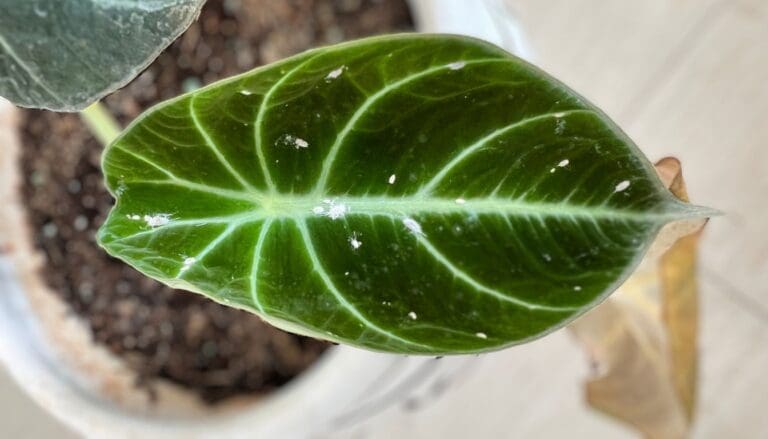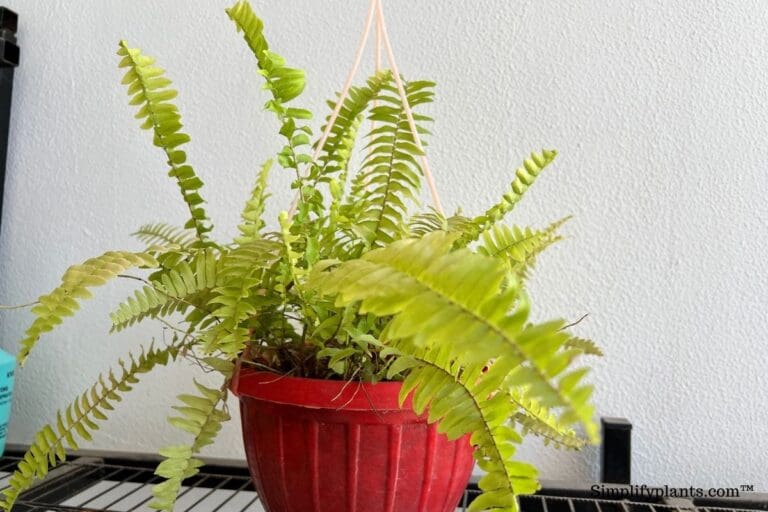Philodendron Leaves Turning Yellow? 7 Causes & Fix
The philodendrons are extremely resilient plants that are easy to handle for both beginners and experienced gardeners. However, sometimes we make some simple mistakes in their care routine, which leads to yellow leaves in philodendron.
Today we’ll learn why your philodendron is turning yellow. Yellow leaves don’t indicate that your plant is dying, but you should also not neglect them.
Some common causes of yellow leaves in philodendrons are too much sunlight, inappropriate watering, cold drafts, low humidity levels, and over-fertilizing. Place the plant under indirect sunlight and water if 80% of the soil feels dry, and increase the humidity around the plant to fix yellow leaves.
You just need to find out the reason behind the yellow leaves in your philodendron, and you’ll need to correct everything that’s going wrong.
You shouldn’t get worried if you see that the old leaves turn yellow, which is natural and a sign of aging.
Before deciding anything, inspect your philodendron properly and then start taking steps to treat the problem. Give your plant enough time to recover, and don’t get impatient.
Let’s understand the causes of yellow leaves on philodendrons and the ways to fix them.
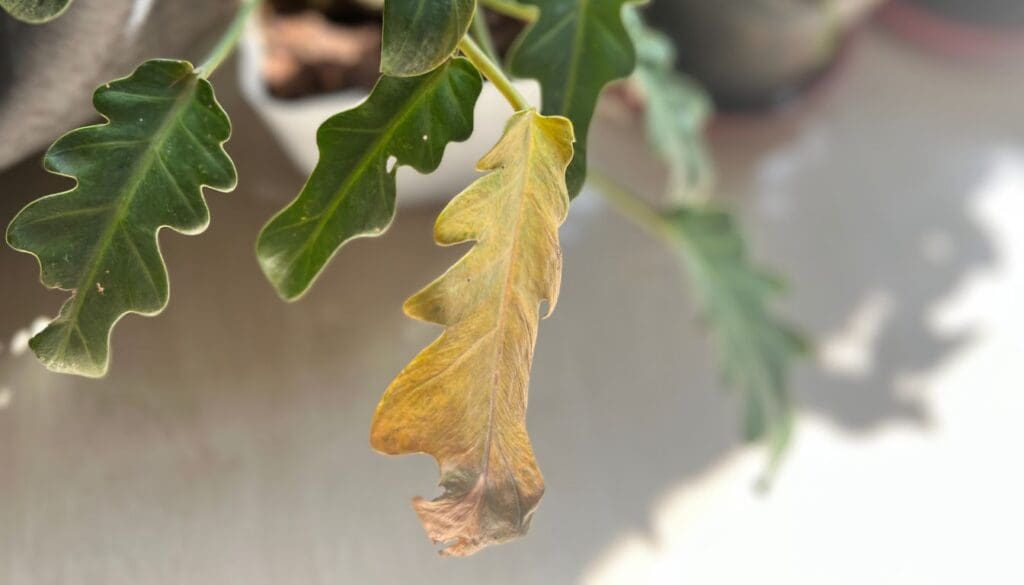
Please note: Simplify Plants is reader-supported. Some links in the post are affiliate links and I get a commission from purchases made through links in the post.
What causes philodendron leaves to turn yellow?
Different reasons can cause the leaves to turn yellow. While some leaves turn yellow due to aging, some turn yellow due to stress. Let’s understand all the reasons now.
Too much sunlight
Light is essential for all plants. If your philodendron gets the right amount of light, it will remain happy and healthy.
However, if it is exposed to intense light or gets more than 2 hours of direct sunlight, it will scorch its leaves, and the soil will dry out fast.
The edges of the foliage will become yellow and brown. This happens because the leaves get dry and discolored when exposed to direct sun.
Too much light not only affects the leaves but can also dehydrate the whole plant, causing other problems that contribute to dehydration.
Insufficient light can also make the leaves of your philodendron turn yellow. When the plant doesn’t have enough light, it cannot photosynthesize, so the leaves start turning yellow.
Over-fertilization
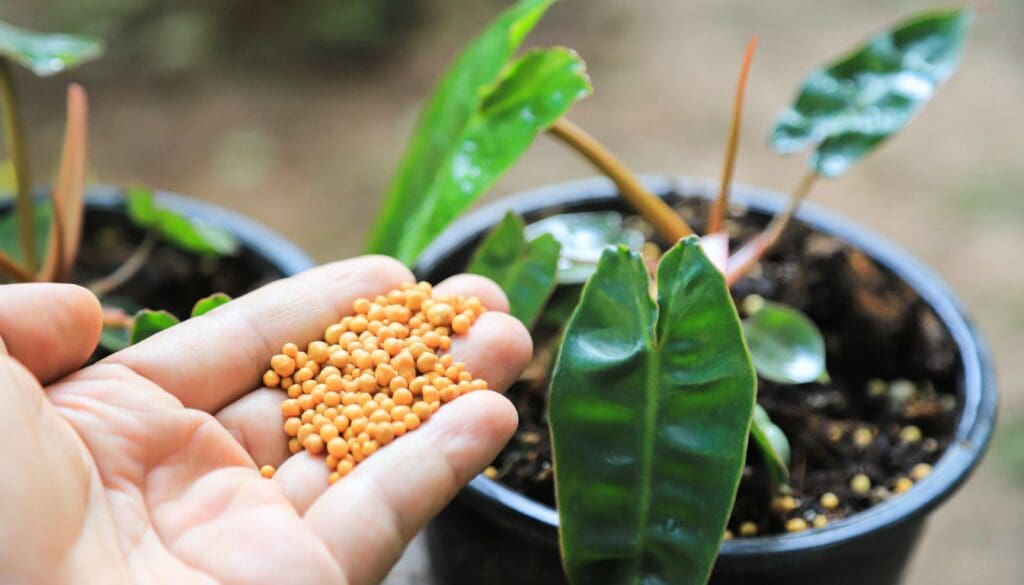
Fertilizers are essential for philodendrons as they contain the micro and macronutrients that help in many functions, such as photosynthesis, root development, and the overall growth of the plant.
If you don’t understand the quantity of fertilizer that the philodendrons require, you can over-fertilize it by giving it an overdose or fertilizing it too frequently.
Excess fertilizer can also alter the soil’s pH level and make it more acidic, harming your philodendron.
Signs of over-fertilization include yellow tips and falling leaves. When there is an excess of urea or NPK granules in the soil, it can lead to leaf burns and yellowing of leaves.
Other than the leaves, over-fertilization damages the roots, and they fail to function well.
Temperature fluctuations
Fluctuation in temperature levels is not something that houseplants adjust well with. They need time to adjust to any change, so they are never ready for temperature fluctuations and feel stressed.
Philodendrons go dormant in winter, and they will not do well if you expose them to low temperatures for a long time. They will show signs of stress through yellow leaves or wilted leaves.
If you neglect these signs and keep the philodendron at a low temperature for a long time, the plant may even die.
Avoid placing your philodendron near windows with high temperatures or cold drafts in winter.
When placing philodendrons near a fireplace to provide warmth during the winter months, try to maintain a distance of a few inches so that the leaves don’t get burnt.
Temperature fluctuations can lead to falling leaves also.
Improper watering
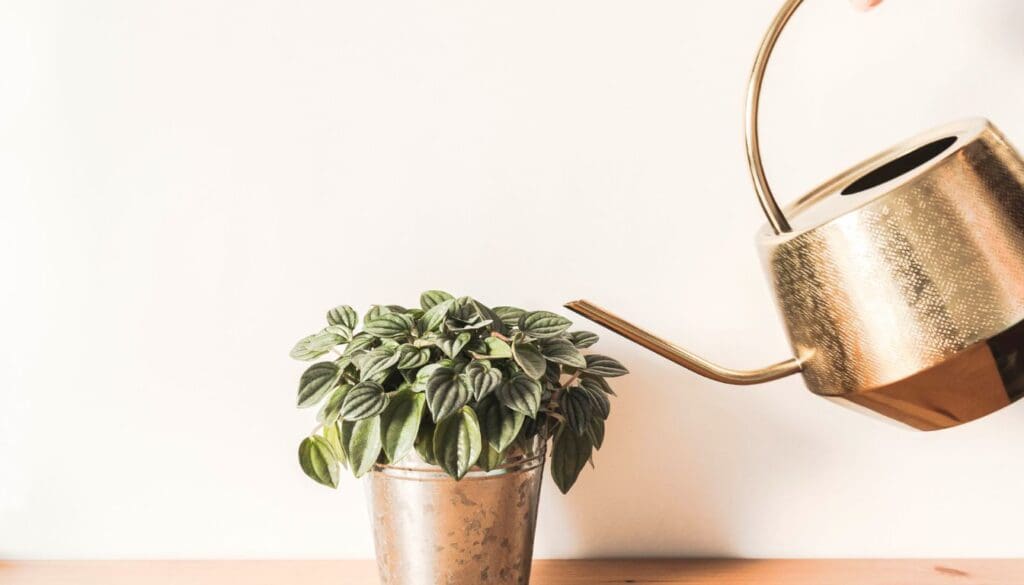
Improper watering in philodendrons leads to yellow leaves, brown tips and edges, and dry leaves.
Following a routine blindly can also lead to underwatering if you keep the soil dry for too long. In this case, the leaves become dry and yellow.
When you overwater your philodendron, it retains excess moisture, which becomes the reason for yellowing leaves.
If you try to follow a routine without checking the soil or keeping the other cultural conditions in mind, you’ll end up overwatering, which will cause soft and yellow leaves.
Sometimes overwatering can be caused due to other reasons.
If you have a root-bound plant, the roots will remain crowded and will not be able to absorb enough water. Therefore, the soil will hold that water and cause overwatering even when you are watering correctly.
This happens because the plant remains in a small pot that doesn’t have space for the roots as they have outgrown the pot.
Your philodendron will get overwatered if you use too heavy soil and don’t contain chunky elements that support proper drainage.
Using regular potting soil can be the culprit as that will retain excess moisture. Even when you water correctly, this soil type will lead to overwatering.
But if the soil is over-draining, it cannot even hold the required moisture; the soil will get dry quicker than usual and lead to an underwatered philodendron.
Root rot
Root rot is caused due to overwatering and a poor drainage system. Root rot invites pests and encourages fungal infections that make the situation worse for your philodendron.
When the roots remain wet for long due to overwatering, they become suffocated due to a lack of oxygen. This leads to rotting, which makes the roots soft and brown.
Other reasons for root rot are heavy soil mix, low light, fertilizing during winters, etc.
Root rot not only damages the roots but makes the whole plant weak. The leaves become discolored and turn yellow and can fall off the plant if not treated.
Pest infestation

Pests such as aphids, mealybugs, scales, and spider mites attack and damage houseplants.
When you have an overwatered philodendron that is already weak, pest infestation acts like a cherry on top and can even kill your plant.
Pests thrive in damp environments that have low light and moist soil. This happens when a plant is overwatered.
Pests make the plant weaker by absorbing all nutrients out of it. They can cause stunted growth, yellow leaves, and falling leaves in your philodendron.
Fungal diseases
Fungal diseases are more common in winter, and they spread fast.
Common fungal infections found in houseplants are powdery mildew, mold, bacterial and fungal leaf spots, etc.
Fungal diseases are caused mainly due to poor drainage systems, stress, or moist and soggy soil.
The fungal diseases can lead to yellow tips or spots on leaves, discoloration, and falling leaves.
How do you fix yellow leaves on philodendrons?
Yellow leaves can be fixed easily if you can identify the problem. Once you figure out where the problem is lying, you can fix it with a bit of care and attention.
We have already discussed the problems; now let’s find the solutions.
Provide proper lighting
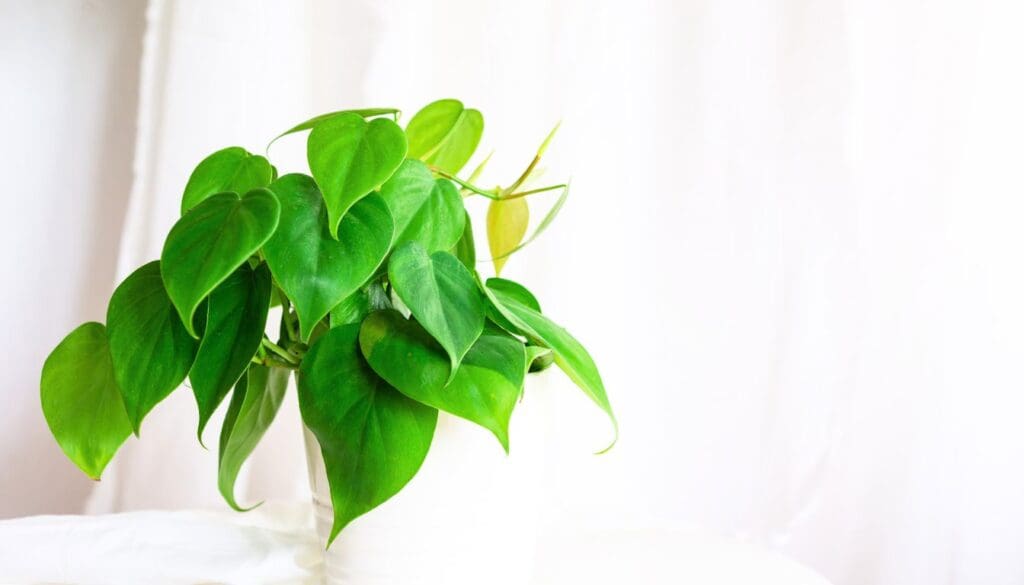
Philodendrons do well in medium to bright lighting conditions. Therefore, you need to find a bright spot with sufficient indirect light to keep your philodendron happy and thriving.
When the philodendron is exposed to direct sunlight, its leaves get scorched, so you should not keep your philodendrons under indirect sunlight. If it gets direct sun from the window, move it away from the window so that it only gets indirect light.
If your philodendron is not getting enough light, you should relocate it to a brighter spot or use artificial lights.
Also read: What Kind Of Light Does A Philodendron Need? (Light Requirements)
Correct fertilization
You should stop over-fertilizing immediately once you realize this is the problem.
First of all, if you are giving the philodendron the recommended dose as per the label, you might be overdoing it. You need to dilute the recommended dose to make it half-strength to make it suitable for your philodendron.
You should use a well-balanced fertilizer with an NPK ratio of 20:20:20 and give it to your philodendron monthly during the growing season.
If you fertilize more frequently, you’ll end up altering the soil’s pH level, which will affect the health and growth of your philodendron.
You should start reducing the fertilization when fall approaches and stop fertilizing totally in winter.
Fertilize your philodendron depending on the growth rate of the plant.
Also read: What Kind Of Fertilizer For Philodendron? (Best Fertilizer+Fertilizer Ratio)
Provide adequate water
If you want to avoid overwatering your philodendron, you should water only when the soil is dry. Start by checking the top layers of the soil, and if it’s dry, you can water it.
Make sure that water drains out through the drainage holes within 1-2 minutes of watering.
Reduce watering in winter as the plant becomes dormant and requires less water.
You can fix a watering schedule for your philodendron, so you don’t forget to water it and keep it underwatered. However, even with a schedule, you should still water your philodendron after checking the soil.
Also read: How Much Water Does A Philodendron Need? (Water Requirement+How Often)
Treat root rot
If you think that the reason behind the yellow leaves of your philodendron is root rot, you should check the roots.
The plant requires repotting if the roots are brown and soft. You must prune the damaged roots and get a new pot with drainage holes.
Create a fresh well-draining soil mix and fill the pot with that soil. Place the philodendron in the pot and add more soil.
You can add some fungicide to the soil and water the philodendron after repotting it.
Get rid of pests.

If your philodendron has a pest infestation, you should separate it and start the treatment immediately.
You must keep the plant in a bright area with good air circulation. If the pests are visible, you can start by handpicking them.
Wash the plant thoroughly with running water to get rid of the pests. Do this a few times.
Spray neem oil solution all over the plant. Do this every day for two weeks to eliminate all the bugs.
You can use commercial pesticides if the pests still don’t go away. Be careful, as some pesticides contain harmful chemicals.
Treat fungal infections
If your philodendron has fungal infections, you need to prune the affected areas.
Add 1 tsp dishwashing soap to 1 liter of water and spray this solution on your philodendron. Let the solution remain on the plant for 5-10 minutes, and then wash the plant with plain water.
If required, repot your philodendron in a pot with a proper drainage system and a well-draining soil mix.
Don’t forget to disinfect the pruners to kill all the bacteria and fungus.
How to prevent the yellowing of leaves in philodendrons?
- Provide your philodendron with proper light, water, and ventilation. Allow air circulation around the plant.
- Evaluate your watering schedule. Philodendrons need water when the top layers of the soil dry. Don’t let the soil get bone dry, as the philodendrons like the soil to remain slightly moist. Ensure that the drainage holes are working and letting excess water drain out.
- Provide 6-8 hours of filtered light to your philodendron. If you don’t have a natural light source available, use artificial lights.
- If your philodendron is planted in an appropriate soil mix, you can fertilize it monthly during spring and summer.
- Soil pH levels should be between 5.0-6.0. You can test the soil pH level using pH testing gadgets.
- Use a pot that is 2″ larger in diameter than the root ball, and the preferable clay or terracotta pot is the best choice as it will help maintain healthy soil and roots.
- Inspect the roots of your philodendron if you get a foul smell from the soil. The roots might get damaged due to pruning or repotting. You can prune some branches and leaves to relieve the roots.
- When you repot your philodendron, you can water your plant with Epsom salt solution to reduce the stress.
- You can sprinkle cinnamon over the soil to prevent fungal attacks and bug infestation.
- Spray neem oil solution every 15 days or 30 days to prevent fungal, bacterial, and pest attacks.
- You should not mist it too often. Use a humidifier that will add more moisture to your philodendrons.
Should I remove the yellow leaves from the philodendron?
Yes, you should remove yellow leaves by pruning them, as those leaves will not become healthy again. Removing them will help the plant as it can concentrate more on new growth.
Ref: Wikipedia.
Recommended Garden Supplies
| Product Image | Our Recommended Gardening Supplies | Check Offers! |
|---|---|---|
Top Top
Top
Top
Top
Top
Top
Top
Top | rePotme Houseplant and Tropical Classic Potting Soil Mix | Check Offer On Amazon |
 Top
Top
Top
Top
Top
Top
Top
Top | Espoma Organic Indoor Plant Food | Check Offer On Amazon |
 Top
Top
Top
Top
Top
Top
Top
Top | GooingTop LED Grow Light 6000K Full Spectrum Clip Plant Growing Lamp | Check Offer On Amazon |
 Top
Top
Top
Top
Top
Top
Top
Top | Soil Moisture Meter | Check Offer On Amazon |
 Top
Top
Top
Top
Top
Top
Top
Top | Govee Hygrometer Thermometer, Bluetooth Enabled! | Check Offer On Amazon |
 Top
Top | LEVOIT Humidifiers for Large Room(Best For Plants) | Check Offer On Amazon |
 Top
Top
Top
Top
Top
Top
Top
Top | Upgraded DIY Automatic Drip Irrigation Kit, 15 Potted Houseplants Support | Check Offer On Amazon |
 Top
Top
Top
Top
Top
Top
Top
Top | Stainless Steel Heavy Duty Gardening Tool Set | Check Offer On Amazon |
 Top
Top
Top
Top
Top
Top
Top
Top | Bonide Insecticidal Soap | Check Offer On Amazon |
 Top
Top
Top
Top
Top
Top
Top
Top | Bonide 32 oz Spray Neem Oil for Organic Gardening | Check Offer On Amazon |
 Top
Top
Top
Top
Top
Top
Top
Top | Garden Safe Fungicide | Check Offer On Amazon |

